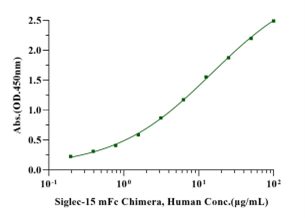Siglec-15, one of the Sialic acid-binding immunoglobulin-like lectins (Siglecs) and type-1 transmembrane protein, is expressed mainly in human macrophages and dendritic cells. It is comprised of a lysine-containing transmembrane domain, two extracellular immunoglobulin (Ig)-like domains and a short cytoplasmic domain. Siglec-15 is highly conserved in vertebrates and acts as an immunoreceptor. It exerts diverse functions on osteoclast physiology as well as the tumor microenvironment. Unlike most Siglecs, which are inhibitory receptors, it associates with adapter proteins DAP10 and DAP12 via a transmembrane Lys274 residue for signal activation. Siglec-15 interacts with adapter protein DAP12-Syk signaling pathway to regulate the RANKL/RANK-mediated PI3K, AKT, and ERK signaling pathways during osteoclast formation in vitro. More recently, high Siglec-15 was also found to promote osteosarcoma progression via the activation of the DUSP1/MAPK signaling pathway, and hepatocellular carcinoma migration via CD44 interaction, which prevented lysosomal degradation. As Siglec-15 is mutually exclusive to PD-L1, it is now emerging as a novel immune inhibitor for anti-PD-1/PD-L1 resistant patients.

